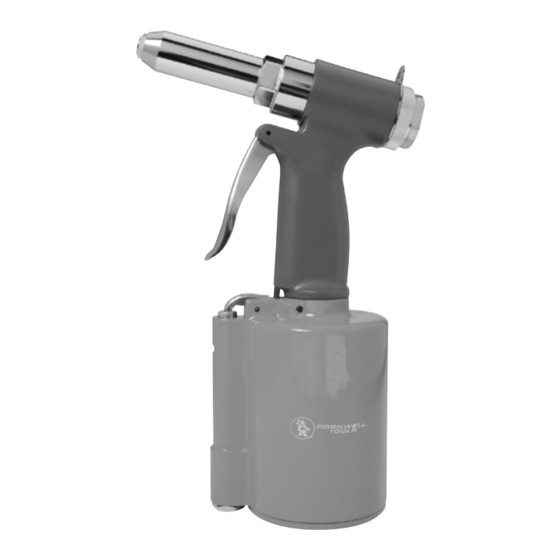
Table of Contents
Advertisement
Quick Links
Operating Instructions • Warning Information • Parts Breakdown
SPECIFICATIONS
Capacity . . . . . . . . . . . . Steel Rivets up to 1/4"
Net Weight . . . . . . . . . . . . . . . . . . . . . 4.6 lbs.
Air Inlet . . . . . . . . . . . . . . . . . . . . . . . 1/4" NPT
Air Consumption . . . . . . . . . . . . . . . . . .4.5 cfm
Air Pressure . . . . . . . . . . . . . . . . . . . 85 - 90 psi
Sizes . . . . . . . . . . . . . . . . . . .3/32", 1/8", 5/32",
. . . . . . . . . . . . . . . . . . . . . . . 3/16", 7/32", 1/4"
• MAX AIR PRESSURE: 90 PSIG,
6.2 bAr
AlwAYS reAd
inSTrucTionS
before uSing
power ToolS
AlwAYS weAr
SAfeTY goggleS
weAr heAring
proTecTion
Some dust created by power sanding, sawing, grinding, drilling, and other
construction activities contains chemicals known to cause cancer, birth defects or
other reproductive harm. Some examples of these chemicals are:
• lead from lead-based paints,
• crystalline silica from bricks and cement and other masonry products, and
• arsenic and chromium from chemically-treated lumber.
Your risk from these exposures varies, depending on how often you do this type
of work. To reduce your exposure to these chemicals: work in a well ventilated
area, and work with approved safety equipment, such as those dust masks that
are specially designed to filter out microscopic particles.
CATPR14
1/4" Heavy Duty
Copyright © Professional Tool Products, 2009
1
CATPR14
Air Riveter
All rights reserved
Rev. 06/02/09
Advertisement
Table of Contents

Subscribe to Our Youtube Channel
Summary of Contents for Cornwell Tools CATPR14
- Page 1 Some dust created by power sanding, sawing, grinding, drilling, and other construction activities contains chemicals known to cause cancer, birth defects or CATPR14 other reproductive harm. Some examples of these chemicals are: • lead from lead-based paints, 1/4" Heavy Duty • crystalline silica from bricks and cement and other masonry products, and...
- Page 2 • A ir under pressure can cause severe injury. Never direct air at yourself or others. Always turn off the air supply, drain hose of air pressure and detach tool from air supply before installing, removing or adjusting any accessory on CATPR14 Rev. 06/02/09...
- Page 3 Lubricate the tool daily with quality air tool oil. If no air line oiler is used, run a half ounce of oil through the tool. The oil can be squirted into the tool air inlet or into the hose at the nearest con nec tion to the air supply, then run the tool. Overfilling will cause a re d uc- Air Inlet Figure 2 tion in the power of the tool. A rust inhibitive oil is acceptable for air tools. WARRANTY Cornwell warrants the CATPR14 for a period of 1 year to the consumer. We will repair the CATPR14 covered under this warranty which proves to be defective in material or workmanship during the warranty period. In order to have your tool repaired, return the tool to any Cornwell Authorized Warranty Center, freight prepaid. Please include a copy of your proof of purchase and a brief description of the problem. The tool will be inspected and if any part or parts are found to be defective in material or workmanship, they will be repaired free of charge and the repaired tool will be returned to you freight prepaid. This warranty gives you specific rights. You may also have other rights which vary from state to state. The foregoing obligation is Cornwell’s sole liability under this or any implied warranty and under no circumstances shall Cornwell be liable for any incidental or consequential damages. Note: Some states do not allow the exclusion or limitation of incidental or consequential damages, so the above limitation or exclusion may not apply to you.
- Page 4 1. Disconnect air flow going to rivet gun. 5. Use a light gauge machine oil to lubricate the parts shown in figure 8. 2. Use the wrench (#36) to remove the head from the frame. (Fig. 5) 6. Re-assemble the Rivet Gun and check the length of the Rivet Gun Head by using the wrench (#35) as shown in 3. Use the wrench to remove the Jaw Housing, Jaws, Jaw figure 9. Pusher, and the Pusher Spring. (Fig. 6) NOTE: Use the edge of wrench stamped 85 4. Thoroughly clean the inside of the Frame Head. (Fig.7) Fig 5 Fig 6 Fig 7 Fig 8 Fig 9 CATPR14 Rev. 06/02/09...
- Page 5 PARTS bREAKDOWN Ref. # Item # DESCRIPTION Ref. # Item # DESCRIPTION RS38401A 5/32" Nosepiece (optional) RS38325 Back-Up O-Ring RS38401B 1/8" Nosepiece (optional) RS38326 Back-Up Ring RS38401C 3/32" Nosepiece (optional) RS38327 Frame Lock Nut RS38401D 1/4" Nosepiece (standard) RS38428...












Need help?
Do you have a question about the CATPR14 and is the answer not in the manual?
Questions and answers